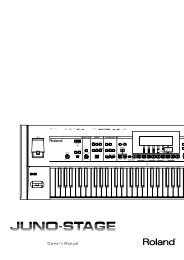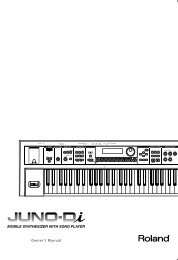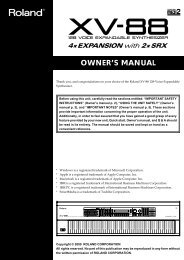Owner's Manual - Roland
Owner's Manual - Roland
Owner's Manual - Roland
You also want an ePaper? Increase the reach of your titles
YUMPU automatically turns print PDFs into web optimized ePapers that Google loves.
Performances<br />
fig.04-005.e<br />
Part<br />
A performance has a patch or rhythm set assigned to each of<br />
the 16 parts, and can simultaneously handle 16 sounds.<br />
Because the Fantom sound generator can control multiple<br />
sounds (instruments) it is called a Multi-timbral sound<br />
generator.<br />
Performance<br />
Part 1<br />
Patch/<br />
Rhythm Set<br />
Part 16<br />
A “part” is something to which you assign a patch or rhythm<br />
set. The Fantom VS has sixteen parts, and you can assign a<br />
patch or rhythm set to each part.<br />
Overview of the Fantom VS<br />
About Simultaneous Polyphony<br />
The Fantom VS can play a maximum of 128 sounds<br />
simultaneously. The following paragraphs discuss what this<br />
means, and what will happen when more than 128<br />
simultaneous voices are requested from the Fantom VS.<br />
Calculating the Number of Voices Being Used<br />
The Fantom VS is able to play up to 128 notes<br />
simultaneously. The polyphony, or the number of voices<br />
(sounds) does not refer only to the number of patches<br />
actually being played, but changes according to the number<br />
of tones used in the patches, and the number of waves used<br />
in the tones. The following method is used to calculate the<br />
number of sounds used for one patch being played.<br />
(Number of patches being played) x (Number of tones used<br />
by patches being played) x (Number of waves used in the<br />
tones)<br />
For example, a patch that combines four tones, each of which<br />
use two waves, will use eight notes of polyphony at once.<br />
How a Patch Sounds<br />
When the Fantom VS is requested to play more than 128<br />
voices simultaneously, currently sounding notes will be<br />
turned off to make room for newly requested notes. The note<br />
with the lowest priority will be turned off first. The order of<br />
priority is determined by the Patch Priority setting (p. 97).<br />
Patch Priority can be set either to “LAST” or “LOUDEST.”<br />
When “LAST” is selected, a newly requested note that<br />
exceeds the 128 voice limit will cause the first-played of the<br />
currently sounding notes to be turned off. When “LOUDEST”<br />
is selected, the quietest of the currently sounding notes will<br />
be turned off. Usually, “LAST” is selected.<br />
93<br />
Overview Connections VS-700C Console VS-700R I/O Fantom VS Appendix

















